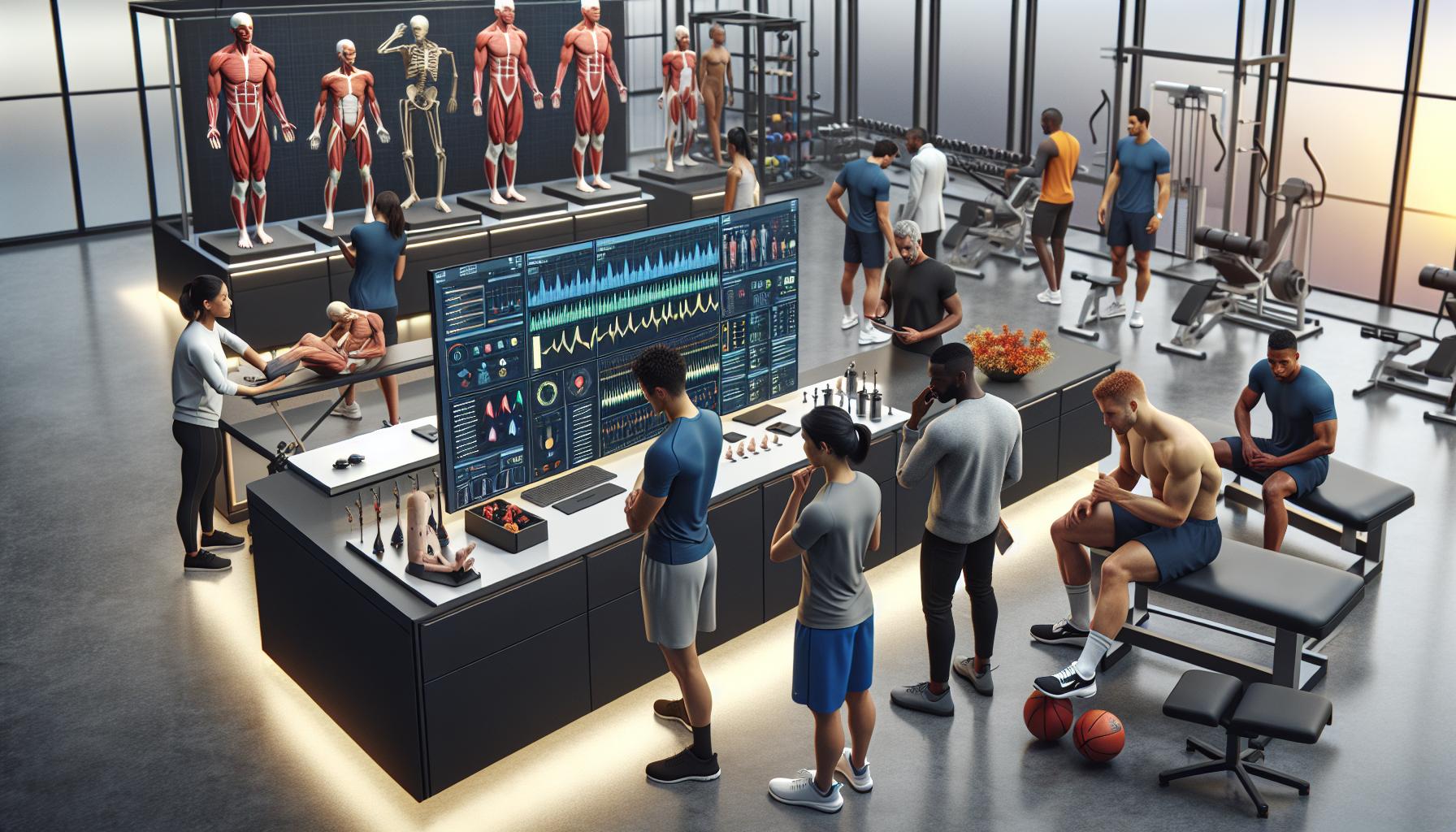As a sports scientist and avid reader, I’ve discovered that sports science books offer invaluable insights into human performance, training methods and athletic development. These comprehensive resources combine cutting-edge research with practical applications that can benefit athletes, coaches and fitness enthusiasts alike.
I’ve spent years exploring the vast landscape of sports science literature and understand how challenging it can be to find the right book that matches your needs. Whether you’re looking to enhance athletic performance optimize training programs or deepen your understanding of sports physiology there’s a sports science book out there for you. Through my experience I’ll guide you through selecting the most influential and informative sports science books that deserve a spot on your bookshelf.
Key Takeaways
- Sports science books have evolved from basic training manuals in the 1920s to comprehensive research-based publications incorporating digital technology and multimedia elements
- Modern sports science literature covers three main categories: athletic training/conditioning, sports medicine/injury prevention, and sports nutrition/recovery
- Leading researchers like Tudor Bompa, Jack Daniels, and Stuart McGill have significantly shaped the field through groundbreaking publications backed by scientific evidence
- When choosing a sports science book, evaluate factors like author credentials, research quality, publication date (within 7 years), and whether it matches your needs for academic or practical applications
- The most effective sports science books combine peer-reviewed research with practical implementation tools like training programs, assessment protocols, and real-world case studies
Sports Science Book
Sports science literature transformed from basic training guides into comprehensive research-based publications over the past 100 years. The advancement in scientific methods revolutionized how we understand athletic performance through published works.
From Training Manuals to Scientific Research
Early sports literature focused on basic exercise descriptions illustrated through simple diagrams in the 1920s. The first sports manuals contained fundamental training principles with limited scientific backing. By the 1950s, publications integrated physiology research documenting metabolic processes muscle adaptation strength development. The 1970s marked a shift toward evidence-based training methods with the introduction of peer-reviewed sports science journals like Medicine & Science in Sports & Exercise.
Key developments in training literature:
- 1920s: Basic exercise technique manuals
- 1950s: Integration of physiological research
- 1970s: Peer-reviewed sports science journals
- 1990s: Biomechanical analysis publications
- 2000s: Sport-specific research compilations
Modern Sports Science Publishing
Digital technology transformed sports science publishing through enhanced data visualization interactive learning platforms. Contemporary sports science books incorporate:
- High-resolution 3D imaging for movement analysis
- Video QR codes linking to technique demonstrations
- Digital supplements with training calculators
- Mobile apps for tracking research implementations
- Online assessment tools for performance metrics
Publishing formats:
| Format Type | Percentage of Market Share |
|---|---|
| Print Books | 45% |
| Digital Books | 30% |
| Hybrid Publications | 15% |
| Online Platforms | 10% |
Leading publishers now release content across multiple platforms simultaneously ensuring accessibility for diverse audiences. Research institutions universities collaborate with publishing houses to produce academically rigorous yet practical resources for coaches athletes sports professionals.
Key Topics Covered in Sports Science Books![]()
 Sports science books explore specialized areas that contribute to athletic performance optimization. These comprehensive resources deliver evidence-based insights across multiple disciplines.
Sports science books explore specialized areas that contribute to athletic performance optimization. These comprehensive resources deliver evidence-based insights across multiple disciplines.
Human Performance and Physiology
Exercise physiology forms the foundation of sports science literature, focusing on bodily responses during physical activity. Key elements include:
- Energy systems (ATP-PC, glycolytic, oxidative)
- Cardiovascular adaptations to training
- Muscular strength development protocols
- Recovery mechanisms post-exercise
- Nutrition requirements for peak performance
| Physiological System | Training Response Time | Adaptation Period |
|---|---|---|
| Neuromuscular | 2-4 weeks | 4-8 weeks |
| Cardiovascular | 3-6 weeks | 8-12 weeks |
| Skeletal | 8-12 weeks | 12-24 weeks |
Biomechanics and Movement Analysis
Biomechanical principles explain optimal movement patterns across sports disciplines. Essential concepts include:
- Joint mechanics during athletic movements
- Force production optimization
- Motion analysis techniques
- Injury prevention strategies
- Equipment design considerations
- Performance anxiety management
- Goal-setting frameworks
- Focus enhancement techniques
- Team dynamics optimization
- Competition preparation strategies
| Mental Skill | Training Duration | Success Rate |
|---|---|---|
| Visualization | 4-6 weeks | 75% |
| Flow State | 6-8 weeks | 65% |
| Stress Control | 3-5 weeks | 80% |
Popular Sports Science Book Categories
I’ve identified three primary categories of sports science books that dominate the market based on readership data from leading academic publishers. Each category addresses specific aspects of athletic performance optimization through evidence-based approaches.
Athletic Training and Conditioning
Athletic training books focus on performance enhancement through systematic training methodologies. These publications cover periodization models, strength development protocols, speed mechanics, agility drills, endurance training systems, power development techniques. The content typically includes exercise libraries, training program templates, assessment protocols, progression matrices for different skill levels. Leading texts in this category incorporate research from exercise physiology labs, featuring EMG analysis data, force production measurements, velocity-based training parameters.
Sports Medicine and Injury Prevention
Sports medicine publications emphasize anatomical understanding, injury mechanisms, rehabilitation protocols, preventive strategies. These resources contain detailed anatomical illustrations, diagnostic flowcharts, rehabilitation timelines, return-to-play criteria. Modern texts integrate findings from biomechanical studies, featuring:
| Injury Type | Recovery Timeline | Success Rate |
|---|---|---|
| ACL Tears | 6-9 months | 85% |
| Hamstring Strains | 3-6 weeks | 92% |
| Ankle Sprains | 2-4 weeks | 96% |
Sports Nutrition and Recovery
Nutrition-focused texts explore fueling strategies, supplement protocols, hydration guidelines, recovery optimization methods. These books present evidence-based recommendations for:
- Macronutrient ratios for different training phases
- Nutrient timing windows for performance enhancement
- Supplementation protocols with clinical trial results
- Hydration strategies based on sweat rate analysis
- Recovery nutrition plans with measurable outcomes
The content includes meal planning templates, supplement timing charts, hydration calculators, recovery nutrition protocols, performance-based case studies backed by peer-reviewed research.
Notable Sports Science Authors and Publications
Sports science literature features prominent researchers who’ve shaped athletic training through evidence-based publications. I’ve identified key authors whose work continues to influence modern sports performance methodology.
Leading Researchers and Their Contributions
Dr. Tudor Bompa revolutionized periodization through his 1983 book “”Theory and Methodology of Training.”” Jack Daniels transformed endurance training with “”Daniels’ Running Formula,”” introducing the VDOT system for calculating optimal training paces. Dr. Stuart McGill’s “”Low Back Disorders”” established core training protocols based on spine biomechanics research. Dr. Mel Siff’s “”Supertraining”” presented comprehensive strength training principles supported by Eastern European research.
| Author | Key Publication | Year | Primary Contribution |
|---|---|---|---|
| Tudor Bompa | Theory and Methodology of Training | 1983 | Periodization models |
| Jack Daniels | Daniels’ Running Formula | 1998 | VDOT training system |
| Stuart McGill | Low Back Disorders | 2002 | Spine biomechanics |
| Mel Siff | Supertraining | 1999 | Strength science integration |
Breakthrough Books That Changed Sports Training
“”Science and Practice of Strength Training”” by Vladimir Zatsiorsky introduced Western audiences to Soviet training methodologies in 1995. Tim Noakes’ “”Lore of Running”” transformed endurance training understanding through its comprehensive analysis of running physiology. “”Essentials of Strength Training and Conditioning”” by the NSCA established standardized protocols for strength coaching certification. Bill Kraemer’s “”Exercise Physiology”” integrated laboratory research with practical applications, creating a bridge between science and training implementation.
| Book Title | Impact Area | Publication Year |
|---|---|---|
| Science and Practice of Strength Training | Strength methodology | 1995 |
| Lore of Running | Endurance science | 1985 |
| Essentials of Strength Training | Professional standards | 1994 |
| Exercise Physiology | Research application | 2012 |
How to Choose the Right Sports Science Book
Selecting an appropriate sports science book requires evaluating specific criteria to match your learning objectives and professional needs. I’ve developed a systematic approach to assess sports science literature based on key factors that determine educational value and practical utility.
Academic vs Practical Applications
Sports science books fall into distinct categories based on their content focus and application methods. Academic texts present research methodologies, statistical analyses, and theoretical frameworks, while practical guides offer exercise demonstrations, training programs, and real-world case studies. Here’s what to consider:
- Research Depth: Academic books contain peer-reviewed studies, experimental data, and statistical analyses
- Implementation Tools: Practical texts include workout templates, assessment protocols, and programming guidelines
- Target Audience: Academic works target researchers and students, while practical guides focus on coaches and practitioners
- Technical Language: Academic texts use scientific terminology, practical guides employ coaching vocabulary
- Visual Elements: Academic books feature graphs and tables, practical guides showcase exercise photographs and technique breakdowns
- Author Qualifications: PhD credentials, research publications, professional certifications in sports science
- Citation Quality: References from peer-reviewed journals, established research institutions, recognized governing bodies
- Publication Date: Updated editions within 5-7 years for current research findings
- Publisher Reputation: Academic presses, recognized scientific publishers, professional organizations
- Research Methods: Clear methodology descriptions, sample sizes, control groups, statistical significance
- External Reviews: Citations in other scientific publications, endorsements from field experts, academic journal reviews
| Credibility Factor | Minimum Standard |
|---|---|
| Author Citations | 50+ in peer-reviewed journals |
| Research References | 100+ primary sources |
| Publication Age | < 7 years |
| Edition Number | 2nd or higher |
| Expert Reviews | 10+ from verified professionals |
The Evolution of Sports Science Literature
Sports science books are invaluable resources that bridge research and practice in athletic performance. From my experience studying and recommending these texts I’ve seen how they empower athletes coaches and fitness enthusiasts with evidence-based knowledge.
I’m confident that by understanding the different categories credibility markers and expert authors you’ll be better equipped to choose the right sports science book for your needs. Whether you’re seeking knowledge about training methodology injury prevention or nutrition optimization there’s a scientifically-backed resource waiting for you.
Remember that the best sports science book is one that aligns with your goals expertise level and practical requirements. I encourage you to use the guidelines I’ve shared to build your own collection of trusted resources that’ll enhance your understanding of athletic performance.
